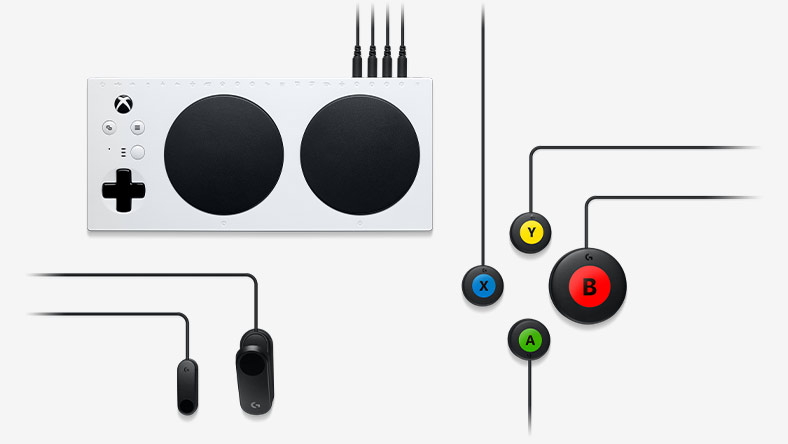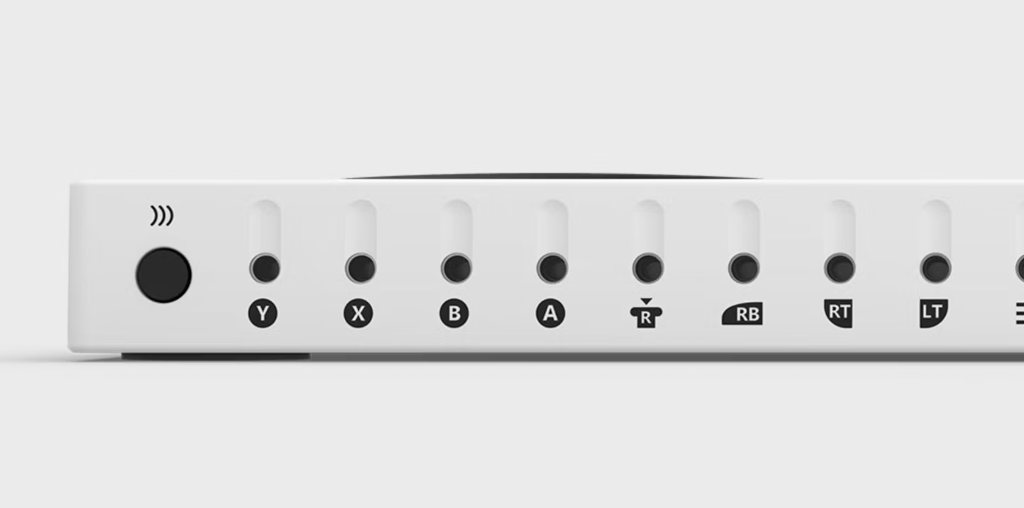
“$100 million was spent designing the Xbox One alone; the device works so well for most people that Xbox controllers are even used outside gaming to pilot drones and control submarine periscopes”
(Wilson, 2019)
In 2018, Microsoft introduced the Microsoft Adaptive Controller (MAC), a groundbreaking gaming device designed to enhance accessibility and foster inclusivity within the gaming industry. The controller’s fundamental purpose lies in mitigating the obstacles encountered by individuals with limited mobility or disabilities while attempting to partake fully in video gaming experiences.1 The Microsoft Adaptive Controller sets a new standard in gaming for social equity in raising awareness for accessibility, breaking conventions with customization, and expanding compatibility for diverse users. It goes beyond the ‘one size fits all’ model that has long-defined gaming equipment, offering a multitude of configurations to accommodate a broader range of usage requirements. The Microsoft Adaptive Controller provides unique flexibility in controller setup. Its large buttons, easy-to-reach ports, and compatibility with various external peripherals make it accessible to a wide range of users.
- Microsoft’s official announcement and press releases about the Microsoft Adaptive Controller ↩︎
Modular Design
“That’s the approach we took: how do we meet people where they are? How does this device adapt to you?”
(Wilson, 2019)
— Bryce Johnson, Inclusivity Lead at Microsoft in describing his approach
The controller’s modular design is a critical component of its focus on inclusivity. The Microsoft Adaptive Controller significantly enhances utility in allowing users to adapt the controller to fit their unique use case (some might require foot petals, while others might need larger buttons). This customization enhances usability and caters to individual needs and preferences while minimizing the learning curve.
The Microsoft Adaptive Controller moves away from traditional conventions that once dictated a singular approach to gaming. Limitations of the existing design made the task of gaming uncomfortable or impossible for some. The controller’s adaptivity – as a tool that enables individuals to tailor their experience – resonates with the social model of disability in mitigating such societal obstacles and physical barriers. In a Fast Company Article, Johnson noted that he often receives inquiries via Twitter asking how the Microsoft Adaptive Controller works for individual use cases. In this context, the controller’s design supports assistive devices and switches, catering to individuals with specific impairments. An individual with quadriplegia (tetraplegia) could utilize sip-and-puff switches linked to the MAC for in-game control, enabling them to partake in gaming. “The Adaptive Controller is designed with the ports and supporting software to enable such use cases, but it still requires ingenuity and improvisation, because no two disabilities are the same”, Johnson Recalled (Wilson, 2019).
Flat Base
One of the core features of the Xbox Adaptive Controller lies in its new structure: enabling gamers to place the controller flat on a table instead of demanding that they grasp and support it. The controller’s traditional shape initially posed a significant physical obstacle for individuals with limited motor control. This design alteration effectively removes a prevalent physical challenge for those with limited motor control and also amplifies inclusivity and accessibility in gaming by eliminating the requirement for individuals to adapt to the conventional controller shape. It shifts the model of gaming from accommodating the disability to making adjustments in the environment.
Programmable Buttons & Compatibility with External Peripherals
In contrast to conventional controllers with small, closely spaced buttons, the Xbox Adaptive Controller features larger, more accessible buttons on its D-pad and face, improving visibility and ease of use. The Xbox Adaptive Controller’s customization has 3.5mm AUX and USB ports on the back, supporting a wide range of accessibility devices, like Buddy Buttons, joysticks, and foot pedals, serving as customizable buttons (Randell, 2023). While some games may offer limited in-game button mapping options, the core layout and functions of the buttons on traditional controllers are usually fixed. The Microsoft Adaptive Controller offers more extensive programmability options, allowing users to customize button assignments and inputs to suit their individual needs. An individual with limited hand dexterity could configure one of the large buttons to perform multiple actions, enabling full participation. Users can assign functions to buttons in a way that best suits their needs; Customization decreases the impact of the physical limitations of traditional controllers.

The medical model asserts that disability is characterized by an individual’s impairment. Customization can simplify controls for individuals with cognitive challenges. An individual with a cognitive impairment could customize a large button to streamline gameplay by initiating a sequence of actions with a single press. For instance, a single button press could initiate character movement, open doors, and collect items, reducing cognitive demands during gameplay.
In summary, the Microsoft Adaptive Controller signifies a noteworthy advancement in gaming hardware, emphasizing new standards for inclusivity and accessibility within the gaming community. Instead of catering to a particular demographic, the Xbox Adaptive Controller acknowledges the diversity of individuals, recognizing that every person is unique. Its adaptive design offers generously sized buttons, and flexibility to incorporate diverse accessories to address the unique needs of gamers contending with mobility limitations or disabilities. The social and medical models of accessibility offer helpful frameworks in conceptualizing societies’ perceptions and actions toward individual differences in ability.
References:
Wilson, M. (2019, September 16). Microsoft’s trickiest product might be its most important. Fast Company. Retrieved September 12, 2023, from https://www.fastcompany.com/90400552/microsofts-trickiest-product-might-be-its-most-important
Randell, L. M. (2023, March 3). How the Xbox Adaptive Controller Helps Gamers With Disabilities. Make Use Of. Retrieved September 12, 2023, from https://www.makeuseof.com/how-xbox-adaptive-controller-helps-gamers-with-disabilities/